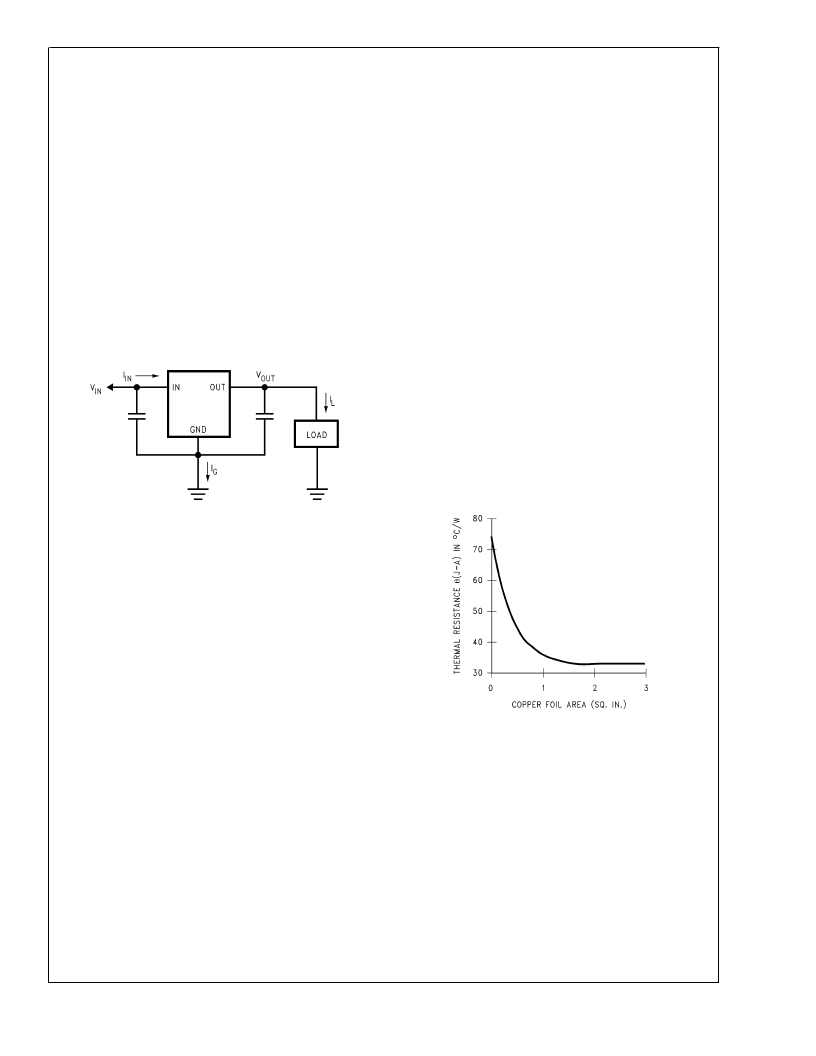- 您現(xiàn)在的位置:買賣IC網(wǎng) > PDF目錄367564 > LM2941CSX Positive Adjustable Voltage Regulator PDF資料下載
參數(shù)資料
| 型號: | LM2941CSX |
| 英文描述: | Positive Adjustable Voltage Regulator |
| 中文描述: | 積極可調(diào)電壓穩(wěn)壓器 |
| 文件頁數(shù): | 11/17頁 |
| 文件大小: | 409K |
| 代理商: | LM2941CSX |

Application Hints
(Continued)
an aluminum electrolytic with a solid Tantalum, with the total
capacitance split about 75/25% with the Aluminum being the
larger value.
If two capacitors are paralleled, the effective ESR is the par-
allel of the two individual values. The “flatter” ESR of the Tan-
talum will keep the effective ESR from rising as quickly at low
temperatures.
HEATSINKING
A heatsink may be required depending on the maximum
power dissipation and maximum ambient temperature of the
application. Under all possible operating conditions, the junc-
tion temperature must be within the range specified under
Absolute Maximum Ratings.
To determine if a heatsink is required, the power dissipated
by the regulator, P
D
, must be calculated.
The figure below shows the voltages and currents which are
present in the circuit, as well as the formula for calculating
the power dissipated in the regulator:
The next parameter which must be calculated is the maxi-
mum allowable temperature rise, T
R
(max). This is calcu-
lated by using the formula:
T
R
(max) = T
J
(max) T
A
(max)
where: T
J
(max)
is the maximum allowable junction tem-
perature, which is 125C for commercial
grade parts.
T
A
(max)
is the maximum ambient temperature
which will be encountered in the applica-
tion.
Using the calculated values for T
R
(max) and P
D
, the maxi-
mum allowable value for the junction-to-ambient thermal re-
sistance,
θ
(JA)
, can now be found:
θ
(JA)
= T
R
(max)/P
D
IMPORTANT:
If the maximum allowable value for
θ
is
found to be
≥
53C/W for the TO-220 package,
≥
80C/W for
the TO-263 package, or
≥
174C/W for the SOT-223 pack-
age, no heatsink is needed since the package alone will dis-
sipate enough heat to satisfy these requirements.
If the calculated value for
θ
(JA)
falls below these limits, a
heatsink is required.
HEATSINKING TO-220 PACKAGE PARTS
The TO-220 can be attached to a typical heatsink, or se-
cured to a copper plane on a PC board. If a copper plane is
to be used, the values of
θ
will be the same as shown in
the next section for the TO-263.
If a manufactured heatsink is to be selected, the value of
heatsink-to-ambient thermal resistance,
θ
(HA)
, must first be
calculated:
θ
(HA)
=
θ
(JA)
θ
(CH)
θ
(JC)
Where:
θ
(JC)
is defined as the thermal resistance from
the junction to the surface of the case. A
value of 3C/W can be assumed for
θ
(JC)
for this calculation.
θ
(CH)
is defined as the thermal resistance be-
tween the case and the surface of the heat-
sink. The value of
θ
will vary from
about 1.5C/W to about 2.5C/W (depend-
ing on method of attachment, insulator,
etc.). If the exact value is unknown, 2C/W
should be assumed for
θ
(CH)
.
When a value for
θ
is found using the equation shown,
a heatsink must be selected that has a value that is less than
or equal to this number.
θ
is specified numerically by the heatsink manufacturer
in the catalog, or shown in a curve that plots temperature rise
vs power dissipation for the heatsink.
HEATSINKING TO-263 AND SOT-223 PACKAGE PARTS
Both the TO-263 (“S”) and SOT-223 (“MP”) packages use a
copper plane on the PCB and the PCB itself as a heatsink.
To optimize the heat sinking ability of the plane and PCB,
solder the tab of the package to the plane.
Figure 3shows for the TO-263 the measured values of
θ
(JA)
for different copper area sizes using a typical PCB with 1
ounce copper and no solder mask over the copper area used
for heatsinking.
As shown in the figure, increasing the copper area beyond 1
square inch produces very little improvement. It should also
be observed that the minimum value of
θ
(JA)
for the TO-263
package mounted to a PCB is 32C/W.
As a design aid, Figure 4 shows the maximum allowable
power dissipation compared to ambient temperature for the
TO-263 device (assuming
θ
is 35C/W and the maxi-
mum junction temperature is 125C).
DS008822-37
I
IN
= I
L
÷ I
G
P
D
= (V
IN
V
OUT
) I
L
+ (V
IN
) I
G
FIGURE 2. Power Dissipation Diagram
DS008822-38
FIGURE 3.
θ
(JA)
vs Copper (1 ounce) Area for the
TO-263 Package
L
www.national.com
11
相關(guān)PDF資料 |
PDF描述 |
|---|---|
| LM2941J-QMLV | Positive Adjustable Voltage Regulator |
| LM2941SX | Positive Adjustable Voltage Regulator |
| LM2941WG-QMLV | Positive Adjustable Voltage Regulator |
| LM2990SX-5.0 | Negative Fixed Voltage Regulator |
| LM2990WG-12-QML | Negative Fixed Voltage Regulator |
相關(guān)代理商/技術(shù)參數(shù) |
參數(shù)描述 |
|---|---|
| LM2941CSX/NOPB | 功能描述:低壓差穩(wěn)壓器 - LDO 1A LDO ADJ REG RoHS:否 制造商:Texas Instruments 最大輸入電壓:36 V 輸出電壓:1.4 V to 20.5 V 回動電壓(最大值):307 mV 輸出電流:1 A 負(fù)載調(diào)節(jié):0.3 % 輸出端數(shù)量: 輸出類型:Fixed 最大工作溫度:+ 125 C 安裝風(fēng)格:SMD/SMT 封裝 / 箱體:VQFN-20 |
| LM2941CT | 功能描述:低壓差穩(wěn)壓器 - LDO RoHS:否 制造商:Texas Instruments 最大輸入電壓:36 V 輸出電壓:1.4 V to 20.5 V 回動電壓(最大值):307 mV 輸出電流:1 A 負(fù)載調(diào)節(jié):0.3 % 輸出端數(shù)量: 輸出類型:Fixed 最大工作溫度:+ 125 C 安裝風(fēng)格:SMD/SMT 封裝 / 箱體:VQFN-20 |
| LM2941CT | 制造商:Texas Instruments 功能描述:IC REGULATOR ADJ +5/20V |
| LM2941CT/LB02 | 功能描述:低壓差穩(wěn)壓器 - LDO RoHS:否 制造商:Texas Instruments 最大輸入電壓:36 V 輸出電壓:1.4 V to 20.5 V 回動電壓(最大值):307 mV 輸出電流:1 A 負(fù)載調(diào)節(jié):0.3 % 輸出端數(shù)量: 輸出類型:Fixed 最大工作溫度:+ 125 C 安裝風(fēng)格:SMD/SMT 封裝 / 箱體:VQFN-20 |
| LM2941CT/LB03 | 功能描述:低壓差穩(wěn)壓器 - LDO RoHS:否 制造商:Texas Instruments 最大輸入電壓:36 V 輸出電壓:1.4 V to 20.5 V 回動電壓(最大值):307 mV 輸出電流:1 A 負(fù)載調(diào)節(jié):0.3 % 輸出端數(shù)量: 輸出類型:Fixed 最大工作溫度:+ 125 C 安裝風(fēng)格:SMD/SMT 封裝 / 箱體:VQFN-20 |
發(fā)布緊急采購,3分鐘左右您將得到回復(fù)。